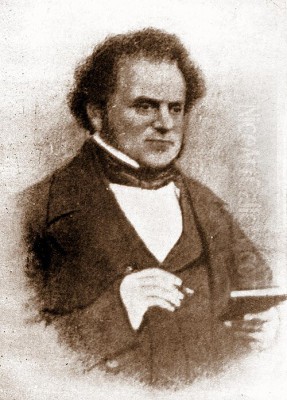
George Baxter (1804-1867) stands as a pivotal figure in the history of printing and popular art. An English artist and printer, he is celebrated for inventing and patenting a commercially viable method of colour printing, known as the Baxter Process. This innovation democratised access to coloured images during the Victorian era, transforming book illustration, decorative prints, and the visual culture of the 19th century. His meticulous craftsmanship and entrepreneurial spirit left an indelible mark, and his prints remain highly sought after by collectors today.
Early Life and Artistic Awakenings in Lewes
George Baxter was born on July 31, 1804, in Lewes, Sussex. His father, John Baxter (1781-1858), was a prominent figure in the town, working as a printer, publisher, and bookseller. This familial environment undoubtedly immersed young George in the world of print and visual communication from an early age. John Baxter himself was innovative, known for his "Baxter Bible" and other illustrated works, providing a stimulating backdrop for his son's burgeoning talents.
From his youth, George displayed a natural aptitude for art. By the age of 20, he was already contributing to his father's business, creating lithographs and wood engravings for publications. These early works, though perhaps not yet indicative of his later groundbreaking achievements, demonstrated a keen eye for detail and a developing technical skill. His time in Lewes allowed him to experiment with different printmaking techniques, laying the foundation for his future innovations. The provincial setting, while perhaps not as artistically vibrant as London, offered him the space and resources to hone his craft under his father's experienced guidance.
The printing industry at this time was undergoing significant changes. While black and white printing was well-established, the production of affordable, high-quality colour images was still a major challenge. Existing methods, such as hand-colouring individual prints, were laborious and expensive, limiting their reach. Baxter would have been acutely aware of these limitations, and it is likely that his early experiences sparked an interest in finding a more efficient and effective way to bring colour to the printed page.
The Move to London and Early Forays into Colour

In 1827, at the age of 23, George Baxter made the significant move from Lewes to London. The capital was the epicentre of Britain's artistic, commercial, and technological advancements, offering far greater opportunities for an ambitious young artist and printer. Upon arriving in London, Baxter apprenticed himself to George Fusell, a notable wood engraver. Wood engraving was a popular medium for illustration, and mastering this skill was crucial for Baxter's later developments.
During this period, Baxter continued to refine his artistic abilities and deepen his understanding of printmaking processes. He was not content with merely mastering existing techniques; his mind was clearly set on innovation. His ambition was to find a way to reproduce the subtle tones and vibrant hues of paintings through mechanical means, making colour accessible to a wider audience.
A significant milestone in his early career came in 1829 with the publication of his first known colour print, "Butterflies." This work, though perhaps simpler than his later, more complex productions, marked his entry into the challenging field of colour printing. It demonstrated his early experiments with using multiple blocks to achieve different colour effects, a principle that would become central to his patented process. This print, and others from this period, showcased his growing confidence and his relentless pursuit of a reliable colour printing method. The artistic environment of London, with its galleries, exhibitions, and community of artists and craftsmen, would have provided both inspiration and a competitive spur for Baxter's endeavours.
The Baxter Process: A Revolution in Colour Printing
The culmination of George Baxter's early experiments and dedicated research arrived in 1835 when he was granted Patent No. 6916 for his unique method of colour printing. This invention, which became known as the "Baxter Process," was a sophisticated and innovative system that combined intaglio and relief printing techniques to produce full-colour images with remarkable detail and tonal subtlety.
The process typically began with a key plate, usually engraved or etched on steel, which provided the main outlines and darker tones of the image. This key plate was printed first, often in a neutral tint like black, grey, or sepia. Following this, a series of meticulously prepared relief blocks, usually made of wood (though sometimes metal, such as copper or zinc, was used), were employed to apply the various colours. Each colour or distinct tint required its own separate block, precisely carved to print only in the designated areas.
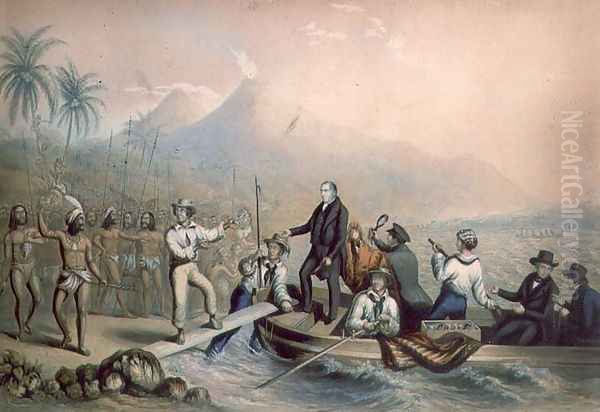
Baxter's genius lay not only in the combination of these techniques but also in the incredible precision required for registration – ensuring that each successive colour block aligned perfectly with the key plate and the previously printed colours. He often used up to ten, and sometimes as many as twenty or more, colour blocks for a single print. The inks he used were oil-based, which allowed for rich, vibrant colours and a smooth, almost luminous finish that mimicked the appearance of oil paintings. This was a significant departure from the watercolour washes often used in hand-colouring.
The Baxter Process was revolutionary because it enabled the mass production of high-quality colour prints at a relatively affordable cost. While not cheap, they were significantly less expensive than hand-coloured engravings or original paintings, bringing art into the homes of the burgeoning Victorian middle class. His method was capable of producing delicate gradations of tone and a depth of colour previously unattainable in mechanical printing. Artists like J.B. Jackson had experimented with chiaroscuro woodcuts in colour in the 18th century, and William Savage had published "Practical Hints on Decorative Printing" (1819-1822) showcasing colour printing from wood blocks. However, Baxter's process, with its steel key plate and multiple oil-based colour blocks, achieved a new level of refinement and commercial viability. Other earlier figures who explored colour printing included Elisha Kirkall, Arthur Pond, and George Knapton, who often used an engraved or mezzotint plate as a base for colours applied by woodblocks.
Themes and Subjects in Baxter's Prints
George Baxter's output was diverse, reflecting the varied tastes and interests of the Victorian public. His prints covered a wide range of subjects, from portraits of eminent personalities to picturesque landscapes, sentimental genre scenes, historical events, and religious iconography. This breadth of subject matter contributed significantly to his popularity and commercial success.
Portraits were a significant part of his oeuvre. He produced likenesses of royalty, including Queen Victoria and Prince Albert, which were highly sought after. His print "The Coronation of Queen Victoria" and "The Opening of Parliament" captured important state occasions with meticulous detail. He also depicted other notable figures of the day, such as missionaries like John Williams, and social reformers. These portraits were not just records of appearance but often imbued with a sense of dignity and character.
Landscapes and topographical views were another popular category. Baxter produced charming scenes of British countryside, such as "Water Mill on the Rye," as well as views of exotic locations, often related to missionary work or colonial expansion. Prints like "The Launch of the Trafalgar" combined technical accuracy with dramatic flair. His depictions of famous landmarks, such as Windsor Castle, were also popular.
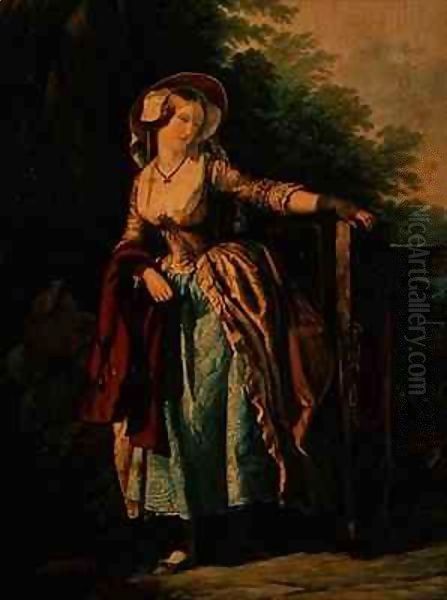
Genre scenes, often with a sentimental or moralising tone, appealed to Victorian sensibilities. "The Parting Look," depicting an emigrant family, resonated with a society experiencing significant emigration. Prints featuring children, animals, and romantic themes were also common. These images often told a story or evoked a particular emotion, making them highly relatable to his audience.
Baxter also produced numerous illustrations for books, particularly religious texts and missionary narratives. His father, John Baxter, had published an illustrated Bible, and George continued this tradition, creating prints for publications like "The Pictorial Album; or, Cabinet of Paintings" (1837), which showcased his colour printing process. His work for the London Missionary Society, including portraits of missionaries and scenes from their travels, helped to publicise and support their efforts. He collaborated with publishers like Charles Knight, who was also interested in disseminating knowledge and art to a wider public.
The Great Exhibition of 1851 provided a perfect subject for Baxter. His large print, "The Exterior of the Great Exhibition," and its companion, "The Interior of the Great Exhibition" (also known as "Gems of the Great Exhibition"), were hugely popular, capturing the grandeur and excitement of this landmark event. These prints demonstrated his ability to handle complex architectural details and large crowds, all rendered in vibrant colour.
Notable Works by George Baxter
Throughout his career, George Baxter produced several hundred different prints, many of which became iconic images of the Victorian era. While it is difficult to single out just a few, certain works stand out for their technical brilliance, historical significance, or popular appeal.
"The Coronation of Queen Victoria" (1841) is one of his most ambitious and historically important prints. It depicts the young queen in Westminster Abbey, surrounded by dignitaries and spectators. The print is remarkable for its intricate detail, the richness of the colours, and the sheer number of figures included. It required numerous blocks and careful registration to achieve the final effect.
"The Launch of the Trafalgar" (1841) is another celebrated work, showcasing a different kind of spectacle. This large print captures the excitement of a ship launch, with crowds of onlookers and the massive vessel dominating the scene. The depiction of the water, the ship's rigging, and the atmospheric effects demonstrate Baxter's mastery of his process.
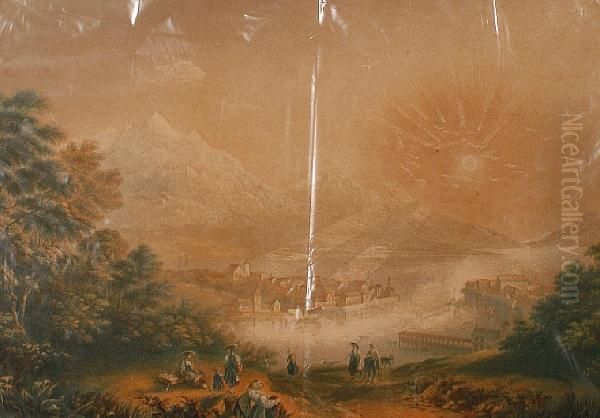
"The Great Exhibition of 1851" prints, particularly "Gems of the Great Exhibition No. 1" (often referred to as "The Interior"), are perhaps his most famous works. These prints captured the marvel of Joseph Paxton's Crystal Palace and the diverse array of exhibits from around the world. The complexity of the interior view, with its vast perspectives and myriad objects, was a triumph of colour printing.
Portraits like "Queen Victoria (on Dais)" and "Prince Albert" were highly successful, catering to the public's fascination with the royal family. His portrait of the missionary "Rev. John Williams" (based on a painting) was also widely circulated, especially after Williams' tragic death in the South Pacific. Baxter's print "The Massacre of the lamented Missionary the Rev. J. Williams and Mr. Harris" was based on sketches provided by crew members who witnessed the event.
"The Parting Look" (1858), based on a painting by Edward Hopley, was one of his most poignant and popular genre scenes. It depicted an emigrant family looking back at their homeland, a theme that resonated deeply with many Victorians. The emotional content, combined with the rich colours and detailed execution, made it a bestseller.
Other notable prints include "Lake Lucerne," "The Ascent of Mont Blanc," "Dogs of St. Bernard," and various floral studies. His smaller prints, often used for book illustrations or as decorative items, such as those found in "Baxter's Agricultural and Horticultural Gleaner," also showcased his skill on a more intimate scale. Each print, regardless of size or subject, was a testament to his meticulous approach and his dedication to achieving the highest possible quality.
Contemporaries, Influences, and Collaborations
George Baxter did not operate in a vacuum. He was part of a dynamic artistic and technological landscape, influenced by predecessors and interacting with contemporaries. His work, in turn, influenced others.
As mentioned, earlier pioneers in colour printing like J.B. Jackson, William Savage, Elisha Kirkall, Arthur Pond, and George Knapton laid some groundwork. While their methods differed, their efforts to move beyond monochrome printing created a context for Baxter's innovations. The rise of lithography, championed by figures like Alois Senefelder (its inventor) and popularised in Britain by artists and printers such as Charles Hullmandel, also contributed to a growing interest in new image-making technologies. Hullmandel, in particular, was a key figure in developing tinted lithography and later chromolithography.

Baxter's process, though unique, eventually faced competition from chromolithography, which was developed and popularised by figures like Godefroy Engelmann in France and later by artists and firms in Britain such as Owen Jones. Owen Jones's work on the "Grammar of Ornament" (1856) showcased the potential of chromolithography for intricate and colourful designs. While Baxter's process offered a particular aesthetic with its oil-based inks and key plate, chromolithography proved to be more adaptable for certain types of commercial work and eventually superseded the Baxter Process in popularity.
Baxter collaborated with various publishers and artists. His early work for his father, John Baxter, was formative. He provided illustrations for books published by Chapman & Hall, Robert Mudie (for whom he illustrated several natural history books between 1829 and Mudie's death in 1840), and the Religious Tract Society. His association with the London Missionary Society was particularly significant, leading to a series of prints depicting missionaries and their work. He worked with John Snow, the society's publisher, from 1837 onwards.
He also reproduced works by contemporary painters. For instance, his print of the Anti-Slavery Society Convention was based on a large painting by Benjamin Robert Haydon. This ambitious project, intended to feature over one hundred portraits, was unfortunately never completed due to its complexity and cost, but a proof of the central portion exists. He also reproduced paintings by popular artists of the day, though sometimes without explicit permission, which occasionally led to disputes. The art world of the time included celebrated painters like J.M.W. Turner, whose atmospheric landscapes were widely admired, and Edwin Landseer, known for his animal paintings. While Baxter's style was distinct, the subjects and sentiments popularised by such painters often found echoes in his own prints. Other prominent Victorian painters whose works defined the era included William Etty, known for his historical and nude paintings, and David Roberts, famous for his detailed depictions of Near Eastern and European architecture.
The success of the Baxter Process led to a number of licensees who were permitted to use his patented method. The most notable of these was Abraham Le Blond. Le Blond & Co. produced many prints using Baxter's process, often of a similar quality and subject matter. Other licensees included Joseph Mansell, William Dickes, and Kronheim & Co., though their adherence to Baxter's meticulous standards varied. These licensees both extended the reach of Baxter-type prints and, in some ways, diluted the uniqueness of his own brand.
The Business of Art: Successes and Struggles
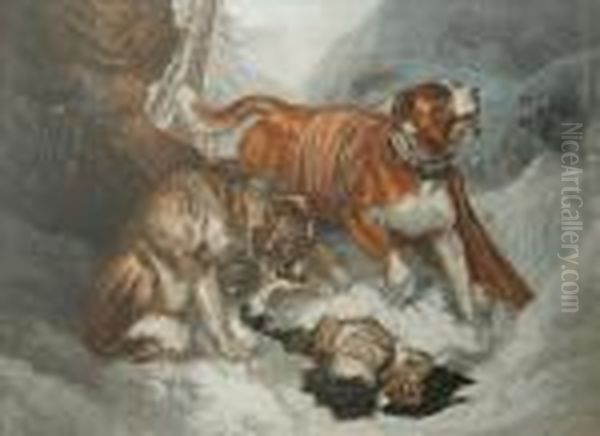
George Baxter was not just an artist and inventor; he was also an entrepreneur. He established his own printing business in London, initially at 29 King Square, then moving to 3 Charterhouse Square, and finally to 11 Northampton Square in 1843. He actively marketed his prints, exhibiting them and seeking prestigious commissions. His royal patronage, particularly the commission to produce a print for the cover of Queen Victoria's "Coronation" music album, was a significant coup.
For a time, Baxter's business flourished. His prints were sold through stationers, booksellers, and print shops across the country and even internationally. He received awards for his work, including an honourable mention at the Great Exhibition of 1851, though he reportedly felt he deserved a higher accolade. The popularity of his prints demonstrated a significant public appetite for affordable colour art.
However, Baxter's career was also marked by financial difficulties. The Baxter Process was complex and labour-intensive, requiring significant investment in materials, equipment, and skilled labour. The meticulous carving of numerous blocks and the careful multi-stage printing process meant that production costs were relatively high. While his prints were cheaper than original artworks, they were still a considered purchase for many.
Competition, particularly from the rapidly developing field of chromolithography, began to erode his market share. Chromolithography, while perhaps not initially matching the specific qualities of Baxter's oil-based prints, proved to be more versatile and cost-effective for many applications. Baxter also faced challenges from infringements of his patent and unauthorized copies of his work.
He attempted to manage his business by licensing his process to other printers from 1849 onwards. While this provided some income, it also meant that prints of varying quality were being produced under the "Baxter Process" banner, potentially affecting the reputation of his own meticulously crafted works. Despite his artistic success and the initial popularity of his prints, Baxter struggled to maintain financial stability.
Later Years, Bankruptcy, and Tragic End
The 1850s and early 1860s saw a decline in George Baxter's fortunes. The initial novelty of his process had worn off, and the market was increasingly competitive. His patent expired in 1849, and although he sought an extension, it was only granted for five years, ending in 1854. After this, his process was open for anyone to use, further increasing competition.
Despite his continued production of high-quality prints, financial pressures mounted. He held a large sale of his stock and plant in 1860, effectively retiring from the business. However, this did not resolve his financial woes. In 1865, George Baxter was declared bankrupt. This must have been a bitter blow for a man who had dedicated his life to his art and invention, and who had achieved such widespread recognition.
His final years were lived in relative obscurity. Tragically, George Baxter's life came to an untimely end on January 11, 1867. He was involved in a street accident near the Mansion House in London, where he was struck by a horse-drawn omnibus. He sustained serious injuries and died at St. Bartholomew's Hospital later that day, at the age of 62. He was buried in Christ Church, Newgate Street, London.
His death marked the end of an era for colour printing. While his process was largely superseded by other technologies, his contribution to the popularisation of colour images was undeniable.
Legacy and Collecting Baxter Prints
Despite the financial difficulties he faced later in life, George Baxter's artistic and technical achievements have endured. His prints, once affordable items for the Victorian home, became highly collectible in the decades following his death. The quality of his workmanship, the charm of his subjects, and the historical significance of his process all contribute to their lasting appeal.
The late 19th and early 20th centuries saw a surge in interest in Baxter prints. Collector societies were formed, such as The Baxter Society (founded in 1921), dedicated to the study and appreciation of his work and that of his licensees. Catalogues raisonnés were published, meticulously documenting his output, most notably C.T. Courtney Lewis's "George Baxter, the Picture Printer" (1924). These resources helped to formalize the collecting field and provide valuable information for enthusiasts.
Today, Baxter prints are found in major museum collections around the world, including the Victoria and Albert Museum in London, the Yale Center for British Art, and numerous regional galleries. They are also actively traded in the art market, with prices varying depending on the rarity, condition, and subject matter of the print. Some of his larger, more complex, or historically significant prints can command substantial sums.
Collectors often specialize in particular types of Baxter prints, such as royal portraits, landscapes, or book illustrations. The condition of the print is paramount, with unfaded colours and clean margins being highly desirable. Original mounts, often bearing Baxter's embossed seal or printed signature, can also add to the value and authenticity of a piece.
The prints of his licensees, particularly those by Abraham Le Blond, are also collected, though generally, they do not achieve the same prices as Baxter's own work. Distinguishing between Baxter's prints and those of his licensees can sometimes be challenging, requiring a keen eye and knowledge of their respective styles and marks.
The Enduring Appeal of George Baxter
George Baxter's contribution to art and printing technology extends far beyond his lifetime. He was a true innovator who successfully bridged the gap between artistic vision and mechanical reproduction. His process brought colour and beauty into the lives of ordinary people in a way that had not been possible before, playing a significant role in shaping Victorian visual culture.
His meticulous attention to detail, his skillful use of colour, and the sheer charm of many of his subjects ensure that his prints continue to delight and fascinate. They offer a window into the aspirations, sentiments, and events of the Victorian era, capturing a world on the cusp of modernity.
As an artist, inventor, and entrepreneur, George Baxter faced both triumphs and tribulations. While his business ultimately faltered, his artistic legacy is secure. The "Baxter prints" remain a testament to his ingenuity and his enduring impact on the history of popular art and colour printing. His work serves as a reminder of the profound influence that technological innovation can have on artistic expression and cultural dissemination.